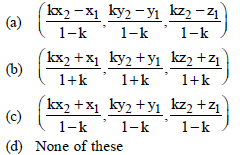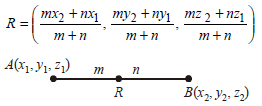Please refer to Introduction to Three-Dimensional Geometry MCQ Questions Class 11 Mathematics below. These MCQ questions for Class 11 Mathematics with answers have been designed as per the latest NCERT, CBSE books, and syllabus issued for the current academic year. These objective questions for Introduction to Three-Dimensional Geometry will help you to prepare for the exams and get more marks.
Introduction to Three-Dimensional Geometry MCQ Questions Class 11 Mathematics
Please see solved MCQ Questions for Introduction to Three-Dimensional Geometry in Class 11 Mathematics. All questions and answers have been prepared by expert faculty of standard 11 based on the latest examination guidelines.
MCQ Questions Class 11 Mathematics Introduction to Three-Dimensional Geometry
Question. The ratio in which the line joining the points (2,4, 5) and (3, 5, – 4) is internally divided by the xy-plane is
(a) 5 : 4
(b) 3 : 4
(c) 1 : 2
(d) 7 : 5
Answer
A
Question. The ratio in which the join of ( 2, 1, 5) and (3, 4, 3) is divided by the plane (x + y – z) = 1/2 is:
(a) 3 : 5
(b) 5 : 7
(c) 1 : 3
(d) 4 : 5
Answer
B
Question. ABC is a triangle and AD is the median. If the coordinates of A are ( 4, 7, – 8)and the coordinates of centroid of the triangle ABC are (1, 1, 1), what are the coordinates of D?
(a) (– 1/2 ,2,11)
(b) (– 1/2 , –2, 11/2)
(c) (–1, 2, 11)
(d) (–5, –11, 19)
Answer
B
Question. Given that A(3, 2, – 4), B(5, 4 – 6) and C(9, 8, – 10) are collinear. Ratio in which B divides AC is 1 : m. The value of m is
(a) 2
(b) 3
(c) 4
(d) 5
Answer
A
Question. If L, M and N are the feet of perpendiculars drawn from the point P(3, 4, 5) on the XY, YZ and ZX-planes respectively, then
(a) distance of the point L from the point P is 5 units.
(b) distance of the point M from the point P is 3 units.
(c) distance of the point N from the point P is 4 units.
(d) All of the above.
Answer
D
Question. If a parallelopiped is formed by planes drawn through the points (2, 3, 5) and (5, 9, 7) parallel to the coordinate planes, then the length of the diagonal is
(a) 7 units
(b) 5 units
(c) 8 units
(d) 3 units
Answer
A
Question. The ratio, in which YZ-plane divides the line segment joining the points (4, 8, 10) and (6, 10, – 8), is
(a) 2 : 3 (externally)
(b) 2 : 3 (internally)
(c) 1 : 2 (externally)
(d) 1 : 2 (internally)
Answer
A
Question. The locus of a point for which x = 0 is
(a) xy-plane
(b) yz-plane
(c) zx-plane
(d) None of these
Answer
B
Question. The perpendicular distance of the point P(6, 7, 8) from xy-plane is
(a) 8
(b) 7
(c) 6
(d) None of these
Answer
A
Question. What is the locus of a point which is equidistant from the points (1, 2, 3) and (3, 2, – 1) ?
(a) x + z = 0
(b) x – 3z = 0
(c) x – z = 0
(d) x – 2z = 0
Answer
D
Question. If the sum of the squares of the distance of the point ( x, y, z) from the points ( a, 0, 0) and ( –a , 0, 0) is 2c2, then which one of the following is correct?
(a) x2 + a2 = 2c2 – y2 – z2
(b) x2 + a2 = c2– y2 – z2
(c) x2 – a2 = c2– y2 – z2
(d) x2 + a2 = c2+ y2 + z2
Answer
B
Question. The distance of the point P(a, b, c) from the x-axis is

Answer
A
Question. The coordinates of the point R, which divides the line segment joining P(x1, y1, z1) and Q(x2, y2, z2) in the ratio k : 1, are

Answer
B
Question. The mid-points of the sides of a triangle are (5, 7, 11),(0, 8, 5) and (2, 3, – 1), then the vertices are
(a) (7, 2, 5), (3, 12, 17), (– 3, 4, – 7)
(b) (7, 2, 5), (3, 12, 17), (3, 4, 7)
(c) (7, 2, 5), (– 3, 11, 15), (3, 4, 8)
(d) None of the above
Answer
A
Question. The points A(4, – 2, 1), B(7, – 4, 7), C (2, – 5, 10) and D (– 1, – 3, 4) are the vertices of a
(a) tetrahedron
(b) parallelogram
(c) rhombus
(d) square
Answer
B
Question. Find the coordinates of the point which is three fifth of the way from (3, 4, 5) to (– 2, – 1, 0).
(a) (1, 0, 2)
(b) (2, 0, 1)
(c) (0, 2, 1)
(d) (0, 1, 2)
Answer
D
Question. The ratio in which the join of points (1, –2, 3) and (4, 2, –1) is divided by XOY plane is
(a) 1 : 3
(b) 3 : 1
(c) –1 : 3
(d) None of these
Answer
B
Question. Let L, M, N be the feet of the perpendiculars drawn from a point P(7, 9, 4) on the x, y and z-axes respectively. The coordinates of L, M and N respectively are
(a) (7, 0, 0), (0, 9, 0), (0, 0, 4)
(b) (7, 0, 0), (0, 0, 9), (0, 4, 0)
(c) (0, 7, 0), (0, 0, 9), (4, 0, 0)
(d) (0, 0, 7), (0, 9, 0), (4, 0, 0)
Answer
A
Question. For every point P(x, y, z) on the x-axis (except the origin),
(a) x = 0, y = 0, z ≠ 0
(b) x = 0, z = 0, y ≠ 0
(c) y = 0, z = 0, x ≠ 0
(d) None of these
Answer
C
Question. The equation of locus of a point whose distance from the y-axis is equal to its distance from the point (2, 1, –1) is
(a) x2 + y2 + z2 = 6
(b) x2 – 4x2 + 2z2 + 6 = 0
(c) y2 – 2y2 – 4x2 + 2z + 6 = 0
(d) x2 + y2 – z2 = 0
Answer
C
Question. The coordinates of the points which trisect the line segment joining the points P(4, 2, – 6) and Q(10, – 16, 6) are
(a) (6, – 4, – 2) and (8, 10, – 2)
(b) (6, – 4, – 2) and (8, – 10, 2)
(c) (–6, 4, 2) and (– 8, 10, 2)
(d) None of these
Answer
B
Question. Point (–3, 1, 2) lies in
(a) Octant I
(b) Octant II
(c) Octant III
(d) Octant IV
Answer
B
Question. If the point A (3, 2, 2) and B(5, 5, 4) are equidistant from P, which is on x-axis, then the coordinates of P are
(a) (39/4 ,2,0)
(b) (49/4 ,2,0)
(c) (39/4,0,0)
(d) (49/4 ,0,0)
Answer
D
Question. If A(3, 2, 0), B(5, 3, 2) and C(– 9, 6, – 3) are three points forming a triangle and AD, the bisector of ∠BAC, meets BC in D, then the coordinates of the point D are
(a) (17/8 , 57/8 ,17/8)
(b) (19/8 , 57/16 ,17/16)
(c) (8/17 , 8/19 ,17/8)
(d) None of these
Answer
B
STATEMENT TYPE QUESTIONS
Question. I. The (0, 7, – 10), (1, 6, – 6) and (4, 9, –6) are the vertices of an isosceles triangle.
II. Centroid of the triangle whose vertices are (x1, y1, z1), (x2, y2, z2) and (x3, y3, z3) is

Choose the correct option.
(a) Only I is true.
(b) Only II is true.
(c) Both are true.
(d) Both are false.
Answer
C
Question. P(a, b, c); Q (a + 2, b + 2, c – 2) and R (a + 6, b + 6, c – 6) are collinear.
Consider the following statements :
I. R divides PQ internally in the ratio 3 : 2
II. R divides PQ externally in the ratio 3 : 2
III. Q divides PR internally in the ratio 1 : 2
Which of the statements given above is/are correct ?
(a) Only I
(b) Only II
(c) I and III
(d) II and III
Answer
D
Question. Consider the following statements
I. The x-axis and y-axis together determine a plane known as xy-plane.
II. Coordinates of points in xy-plane are of the form (x1, y1, 0).
Choose the correct option.
(a) Only I is true.
(b) Only II is true.
(c) Both are true.
(d) Both are false.
Answer
C
Question. I. The distance of the point (x, y, z) from the origin is given by

II. If a point R divides the line segment joining the points A((x1, y1, z1)) and B((x2, y2, z2)) in the ratio m : n externally, then

Choose the correct option.
(a) Only I is true.
(b) Only II is true.
(c) Both are true.
(d) Both are false.
Answer
C
Question. Consider the following statement
I. Any point on X-axis is of the form (x, 0, 0)
II. Any point on Y-axis is of the form (0, y, 0)
III. Any point on Z-axis is of the form (0, 0, z)
Choose the correct option.
(a) Only I and II are true.
(b) Only II and III are true.
(c) Only I and III are true.
(d) All are true.
Answer
D
Question. I. The coordinates of the mid-point of the line segment joining two points P(x1, y1, z1) and Q(x2, y2, z2) are

II. If a point R divides the line segment joining the points A(x1, y1, z1) and B(x2, y2, z2) in the ratio m : n internally, then

Choose the correct option.
(a) Only I is true.
(b) Only II is true.
(c) Both are true.
(d) Both are false
Answer
C

